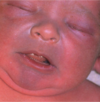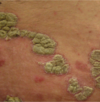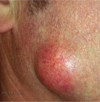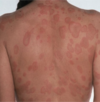Skin Disorders & Wounds Flashcards
The _________ layer of the skin is thin and devoid of blood vessels and divided into outer hrny layer and inner cellular layer. It depends on the _______layer for nutrition.
Epidermis ; Dermis
The _______ layer is supplied with blood, contains connective tissue, sebaceous glands, sweat glands, and hair follicles.
Dermis
The _________ contains adipose (fat tissue).
Subcutaneous tissues / hypodermis
Functions of the skin (4)
- ) Homeostasis - maintain pH
- ) Provides boundaries, protects underlying tissues from microorganisms, and radiation
- ) Modulates body temp
- ) Synthesizes vitamin D
_______ is the brownish pigment of the skin, genetically determined, increased by sunlight
Melanin
_______ is a golden yellow pigment that exists in subcutaneous fat and in heavily keratinized areas like palms and soles
Carotene
__________ is a bright red pigment, predominates in arteries and capillaries.
Oxyhemoglobin
_______ is darker somewhat bluer pigment from oxyhemoglobin losing its oxygen to the tissues. Increase in this pigment causes _________.
Deoxyhemoglobin ; cyanosis
_______ hair is short, fine, inconspicuous, and relatively unpigmented.
Vellus
________ hair is coarser, thicker, more conspicuous and usually pigmented (ex: scalp hair and eyebrows)
Terminal
Know the locations of:
lunula (whitish moon)
proximal nail fold
cuticle
lateral nail fold.

T/F
Nail plate gets pink in color from underlying vasular nail bed
True
T/F
Fingernails grow 0.1 cm/day
False
They grown 0.1mm/day
(and toenails grow slower than this)
______ glands produce a fatty substance that’s secreted onto the skin surface through the hair follicles
Sebaceous glands
_______ glands are present on all skin surfaces except palms and soles.
Sebaceous glands
There are two types of sweat glands.
_______ glands are widely distributed and open directly onto the skin surface, and help control body temperature.
_______ glands are found chiefly in axillary and genital regions, open onto hair follicles, and stimulated by emotional stress.
Eccrine glands ; Apocrine glands
ABCDE screening moles for Melanoma
- *A** for Asymmetry
- *B** for irregular Borders, especially ragged, notched, or blurred
- *C** for variation or change in Color, especially blue or black
- *D** for Diameter > or equal to 6 mm or different from others, especially if changing, itching, or bleeding
- *E** for Elevation or Enlargement
When assessing color for during a skin exam, what do you look for?
- increased pigmentation or loss of pigmentation
- redness & pallor (fingernails/ mucous membranes)
- cyanosis (central (trunk) & peripheral (fingers/toes))
- jaundice
What do you look for when assessing moisture when doing the skin exam?
dryness, sweating, and oiliness
How do you assess temperature when doing the skin exam?
use the backs of fingers to assess skin and any red areas for warmth
How do you assess mobility and turgor when doing the skin exam?
Lift skin and not ease with which it lifts up (mobility) and speed with which is returns into place (turgor - hydration status)
_______ is a slightly but uniformly pigmented macule or patch with a somewhat irregular border. It is flat and usually 0.5 - 1.5 cm in diameter.
Café-Au-Lait Spot
Six or more Cafe-Au-Lait spots each with a diameter > 1.5 cm suggests __________
Neurofibromatosis
___________ is depigmented macules (flat) appear on the face, hands, feet, and extensor surfaces (ex: back of elbow or neck), may be herediatary.
Vitiligo
* note * Brown pigment is normal skin, while the pale areas are vitiligo
This depicts which type of skin condition?

Cyanosis - bluish color that is visible centrally as in the case with congenital heart disease
Which skin condition does this picture depict?

Cyanosis - Bluish color that is visible peripherally in the fingertips (with congestive heart failure or Raynaud’s disease)
________ is most easily and reliably seen in the sclera (as well as other mucous membranes)
Jaundice
Causes of ________ include liver disease and hemolysis of red blood cells
Jaundice
This depicts which skin problem?

Erythema - red hue, increased blood flow, seen in that picture as the “slapped cheeks” of “Fifth disease” (not important Jenny said)
_______ is an immune-mediated disease that affects the skin. It occurs when the immune system mistakes the skin cells as a pathogen, and sends out faulty signals that speed up the growth cycle of skin cells
Psoriasis
Which skin disease presents as silvery scaly lesions?
A. Papules
B. Eczema
C. Erythema
D. Psoriasis
D. Psoriasis
________ is mainly on extensor surfaces and is associated with strokes.
Psoriasis
Which skin condition is an allergic disease associated with asthma, and includes dryness and recurring skin rashes that are characterized by redness, skin edema (swelling), itching and dryness, crusting, flaking, blistering, cracking, oozing, or bleeding?
Atopic eczema
_______ is the skin condition that presents as red or purplish in the shape of a butterfly involving the bridge of the nose but spares the nasolabial folds of the face. It is macular with sharp edges and not itchy.
Malar rash of Lupus
(present in 46-65% of lupus sufferers)
This is a patch of closely grouped papules more than 2/5 in (1 cm) across is called a _______.

Plaque (also seen in psoriasis)
What is the primary skin lesion that is solid, raised, and less than 1 cm across? It’s also seen in warts, syphilis, psoriasis, seborrheic and actinic keratoses, lichen planus, and skin cancer.

Papules
________ are associated with keratinous cysts, lipomas, fibromas, and some types of lymphomas
A. Plaques
B. Papules
C. Nodules
D. Cysts
E. Wheals
C. Nodules
Which of the primary skin lesions is solid (.0.5 cm) that has distinct edges and that’s more deeply rooted that a papule, is “palpable” because it can be felt as a hard mass distinct from the surrounding tissue

Nodule
This is a nodule filled with expressible material, either liquid or semisolid. Which type of primary skin lesion is this?

Cyst
________ is a skin eleation caused by swelling that can be itchy and usually disappears soon after erupting, and is generally associated with an allergic reaction (such as to a drug or insect bite).
Wheal



